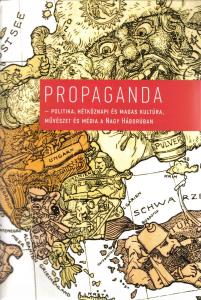
Propaganda
Propaganda – Politics, Everyday and High Culture, Art and Media during the Great War
Edited by Iván Bertényi Jr., László Boka, Anikó Katona
NSZL, Budapest, 2016. 542 pages
ISBN 978 963 200 660 4
In January 2016, National Széchényi Library held a two-day interdisciplinary conference within the framework of its project to study the hinterland propaganda of World War I, its changes in time, forms and tendencies in various areas of academic research. NSZL aimed at placing this complex topic in the focus of attention from the centenary year of the Great War primarily through its Grand Exhibition that opened in the autumn of 2015 and by several other events and publications.
This volume contains the selected and edited studies of the research conference held to discuss the questions raised by the successful exhibition with the experts of specialized areas. Our selection seeks to establish a link between the results of different academic disciplines like history science, and history of press, literature and art. Nearly thirty writings are gathered here to examine the variations of World War I hinterland propaganda in politics, press, literature and visual culture.
CONTENTS:
- GÁSPÁR GRÓH: Once upon a time there was a war
PROPAGANDA AND ITS VARIATIONS
- IGNÁC ROMSICS: World War I – from the perspective of 100 years
- LÁSZLÓ Z. KARVALICS: The Great War and propaganda
- ROMAN HOLEC: Austria-Hungary as „a murderer of small nations”
- FERENC POLLMANN: Atrocity propaganda and the Austro-Hungarian-Serbian war
- TAMÁS SZÉKELY: The cult of allied rulers in Hungary during World War I
- EMESE SZOLECZKY: „Happy and peaceful infantry entrenchment?”
- NORBERT STENCINGER: „We turn to you with confidence and hope”
- ESZTER BALÁZS: Self-mobilization of the Hungarian society at the beginning of World War I.
- SZILVIA ZÁVODI: War propaganda on everyday objects
- RÓBERT TÖRÖK: „We serve just as long as the stocks last” –food traders in World War I
- VILMOS KOVÁCS: The Hungarian military industry in the Austro-Hungarian Empire
THE PRESS AND ITS CONTROL
- GÉZA BUZINKAY: Press and/or propaganda during World War I
- DÁNIEL SZABÓ: The Hungarian press at the outbreak of the war
- VINCE PAÁL: Control of the press in Hungary during the years of World War I
- TIBOR BALLA: The organization and operation of the Austro-Hungarian Press Headquarters in World War I
- TIBOR KLESTENITZ: Propaganda of the Great War as seen by the Hungarian press
- BOLDIZSÁR VÖRÖS: Spaces, masses, films
LITERATURE AND WAR
- MIKLÓS VERES: Wars of the next century
- ANDREA BORBÁS: But poems are being written
- LÁSZLÓ BOKA: ,,Songs from the great times?”
- BEATRIX VISY: The poem as anti-propaganda
- ZSUZSANNA RÓZSAFALVI: Emőd Tamás’s works of war thematics on Modern Színpad (Modern Stage)
- ANNA CSÉVE: „…if there is war, why there is not war?”
- ZSÓFIA SZILÁGYI: „What happened to him had no sign or word”
ART AND VISUAL CULTURE
- GYÖRGY SZÜCS: Café, art studio and entrenchment, or the adventures of Sergeant Herman in World War I
- JENŐ MURÁDIN: Transylvanian artists in World War I
- IVÁN BERTÉNYI JR.: Nailing statues
- ANIKÓ KATONA: War poster: an effective weapon or patriotic kitsch?
- BOTOND GERGŐ SAMU: Chained colonies, fighting dogs, Sacred War, and the ring of steel of the Entente
Shopping
Our publications are available in our bookshop, or can be ordered from the Publications Department of the NSZL using the contact details below: Főigazgatói Kabinet kiadványtára, Országos Széchényi Könyvtár, 1276 Budapest P.O. box 1205., phone: 06-1-23-23-506, e-mail: kiadvanytar@oszk.hu.




